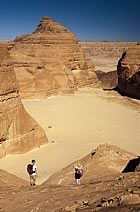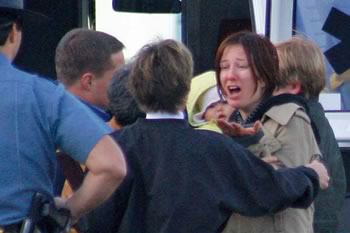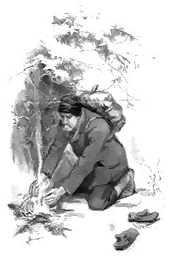One story that will stick with me forever is Jack London’s short story of winter survival, To Build a Fire. It seemed as if it was on the curriculum of every Canadian grade school when I was a young teenager, and I’m sure everyone who’s taken a winter survival course was told to read it as a cautionary tale.

Later, at Crazy Go Nuts University, at the start of COMM 101 — “Intro to Business” — one of the first group exercises we did in the class was to explain how we’d handle a hypothetical situation. The purpose of the exercise was to demonstrate group dynamics and decision-making, and it went like this: We were in a small plane that crashed in the desert somewhere in the southwestern U.S.. The pilot is dead, and we have limited supplies: some water, a knife, a little food, salt tables, a large white parachute and a few other items. There’s nothing but flats as far as the eye can see. What do we do?
I argued for staying with plane, taking shelter, stretching our water supply and making ourselves as findable as possible. Someone else in our group, who’d just seen the movie Alive a few days prior, argued that we’d die if we stayed there. She said that the only way to survive was to make our way towards civilization or a road.
Although the purpose of the exercise was to explain the 90/10 dynamic of groups (generally, a group is 10% alpha dogs — me and the Alive fan — and 90% pack) and other aspects of group decision-making, we were given the correct answer, and that was to stay put and use the parachute as both shielding against the sun and a way of being spotted from the air. Even after the explanation, the Alive fan was unconvinced. “But…Alive…” she said.
One of these days, I’m going to have to rent that movie.

Kati Kim, after being rescued after nine days of being trapped in a car on a mountain in Oregon.
I bring up both these stories because the story of James Kim and his family reminded me of them. If you’re a follower of the tech news or live on the American west coast, you’ve probably heard this news. James Kim, an editor for CNET and familiar face for G4/TechTV viewers, his wife Kati and daughters Penelope and Sabine went missing days ago on a road trip to the Pacific Northwest. Their story, in a nutshell: they took a mountain road that they thought would be a shortcut and ended up getting trapped in very deep snow. They ran the engine to power the heater until it ran out of gas, and then burned the tires. Finally, James set off to get help. Kati and the girls were found alive nine days later and are in good condition. The search for James continues.
I’m very happy that Kati and the kids have been found, and my heart goes out to them. I hope they find James alive and well, and soon.
Back in the fall of 1986 and the winter of 1987, I made the drive between Toronto and Montreal an average of once every three weeks to party with my sister and her friends at McGill (those stories should be blogged someday). The driving, while nowhere nearly as treacherous as the mountain routes taken by the Kim family, could still be pretty bad at times; sometimes, the snowfall and winds would be so bad that we had to pull over and wait. I never let the gas gauge drop significantly below half-full, and I always had an extra sweater, a small shovel, a road safety kit and some Wunderbars handy. The longest I ever had to sit still in a storm was about five hours, after which I had to dig out the car.
As I mentioned earlier, the Kims’ problem is orders of magnitude worse than anything I’ve faced. Highway 401 is not the same thing as the mountain pass they took. Even if I’d run out of gas during a blizzard on the 401, help is never far away from that very well-travelled route.
Here’s a question for the winter survival experts: if in the situation like the Kims (let’s ignore the prevention aspect for the moment), is it better to stay put, or go for help?


9 replies on “Survival”
In your Queens U. “Utah crash” scenario it’s a no-brainer for anyone with pilot training. Remain with the aircraft, because modern G/A planes are required to carry an ELT (emergency locator transmitter) that emit a signal on VHF comms frequency 121.5 (a.k.a “Guard”) and 243.0 MHz. The signals can also be located by satellite and also by any aircraft that is monitoring 121.5. The ELTs are usually impact- or water-activated but can also be manually activated in case the auto-activation doesn’t trigger. If you stay with the plane there is an excellent chance that a satellite or other aircraft will detect your signal and notify SAR. There is also your flight plan, of course, filed with local ATC, listing your departure time, intended route, and arrival time. If you fail to show up on time, and do not call to specify a diversion/change in destination, after a significant amount of time has passed, ATC will get concerned and notify SAR. Either way, via ELTs or failure to arrive per flightplan, somebody will come looking for you along your planned route. Going off the planned route makes it less likely someone will find you.
Cars, of course, do not have ELTs nor does anyone register a driving plan with the local authorities. Tougher call. In that case staying with the car, especially if it is in a heavily wooded, sparsely populated area, seems like slow suicide. But unless you know your orienteering skill and hiking endurance under winter conditions it is risky to venture out from the car. It is easy as hell to get disoriented (and therefore dead) in remote areas. I wouldn’t attempt to have the whole family hike out, that is far beyond the capabilities of those young kids. He probably made the best choice — have kids and mom remain with the car while dad goes for help — even if it didn’t turn out okay for him. Not every family’s relatives will have the resources to hire a helo for air search.
As with your desert scenario, you stay put unless you are less than a one hour walk from a place that has a high-probability of finding assistance (well traveled road, a home or store you passed a short while ago, etc.)
In the desert it is all about water, and you would stay put because that conserves water and once you run out of water you have about three days of life left. When stranded in snow it is all about shelter/warmth.
A car is reasonably good shelter, and the snow provides additional insulation. There are various tricks you can do to warm the car cabin with an external fire, but in almost all such situations the best answer is always to stick with your shelter unless staying at the accident location is dangerous.
Not an expert, but in explanation of the Alive scenario – they were in the Andes (i.e. a very remote place) and the event took place in the 1970s – I don’t know if planes had transponders in those days. A lesser-known film, Wings of Courage, has a French aviator in the 1920s having to get out of the Andes on his own as well (in IMAX at that) -but again, lower-tech era.
Moral – it’s best to stay with the vehicle, unless you know for sure you’re either close to help or so far from it that it’s not going to make a difference.
Seems like a good time to plug Survivorman – the latest in the line of watching someone else in trouble for entertainment’s sake. See: http://science.discovery.com/convergence/survivorman/map/map.html for the areas/semi-contrived situations.
That’s an interesting show and I’ve seen it a few times… but to be fair, he always attempts to make it back to civilisation. he might linger around the incident site for a couple of days but at the end he always makes the effort to get out under his own steam. I don’t know whether the trek-out is always good practical advice for the average Joe, or simply due to the demands of the show format.
There is a lot of stuff that Les does that I wouldn’t attempt – like wading thru a waste deep swamp. But he is very entertaining.
I’m no expert, but the odds are greatly in your favor to stay put. However, there are isolated stories where the person stayed put & died. There was an guy a few years back that also took a snow pass road in Oregon in a pickup. The park rangers closed the road later that day & didn’t drive it like they are supposed to. That guy sat in his pickup for like 40+ days & slowly starved to death. Gotta be a rough way to go!
Every scenario has to be taken on it’s own merit. My personal strategy is that if I’m ever caught in a snowbound situation will be to stay put unless I’ve got great winter clothing & boots. And it that case I will stick to the road that I drove in on… going off road in unknown area is suicide if you ask me.
I don’t know much about blogs but this is a good one, it has answered some questions. Others are still unanswered…
James Kim had waited long enough, rescue was not on the way unless you count his friends and family. Other motorists have been stranded on this stretch of road before, one has to wonder what the local search and rescue are capable of and how well they trained and equiped. Of course I say these things in hindsight but I would guess James was assuming the same things when he left the car to look for help.
It’s tough to immagine what was going through his mind when he left the car but I don’t believe he was thinking clearly, a combination of low blood sugar and hypothermia. Lost people will almost always go downhill even if they don’t mean to, it’s easier. He went into a ravine or gorge. It might make sense in that he was attempting to go over a mountain ridge in the car and never made it, he turned around.
It appears he left the ‘main’ road in ‘an attempt to turn around'[the car]. Did he realize he wasn’t on the ‘main’ road? If he thought he was still on that road it would have been logical to follow it downhill.
A car is great shelter, I’d stick with it. Perhaps, again in hinsight, he stuck with it too long. He may have allowed himself to get too weak, lack of judgement follows.
I’m no expert in these matters but have had some personal experience. My best advice would be; if you don’t know where you are going do not leave the vehicle (You’re starting out lost).
No doubt “stay put” is best, but he made the “other” best choice, a gamble with his own life for the life of his family. If no one had found the car, there would be no irony whatsoever in his decision to walk…
No one has said it because it’s callous, but perhaps they were overconfident in their AWD. But he *was* thinking straight. He was thinking of his family and looking at a map. 6 days was it? in a car in the cold… SIX DAYS to do nothing. 144 hours. Virtually no food. That is so long.
I would have waited probably 3 days max and studied the map until I couldn’t see straight, then probably died by the 5th day.
I have had the tiniest tastes of lost, hungry, cold, and tired in the Oregon woods and I feel deeply for the man and respect the choices he made in a desperate situation.